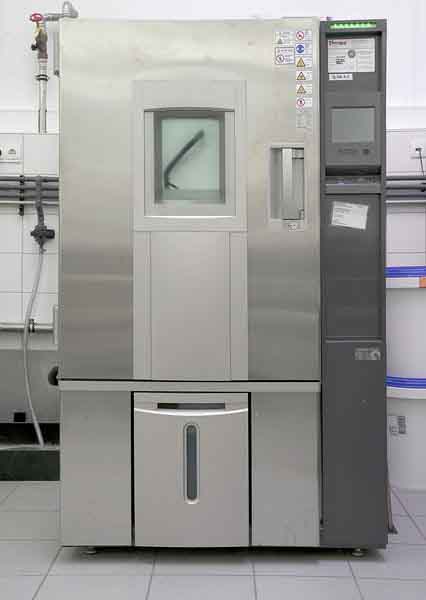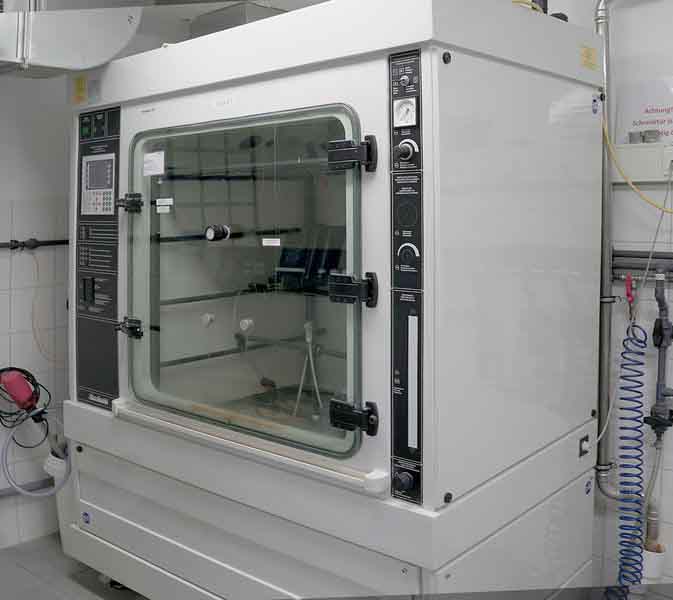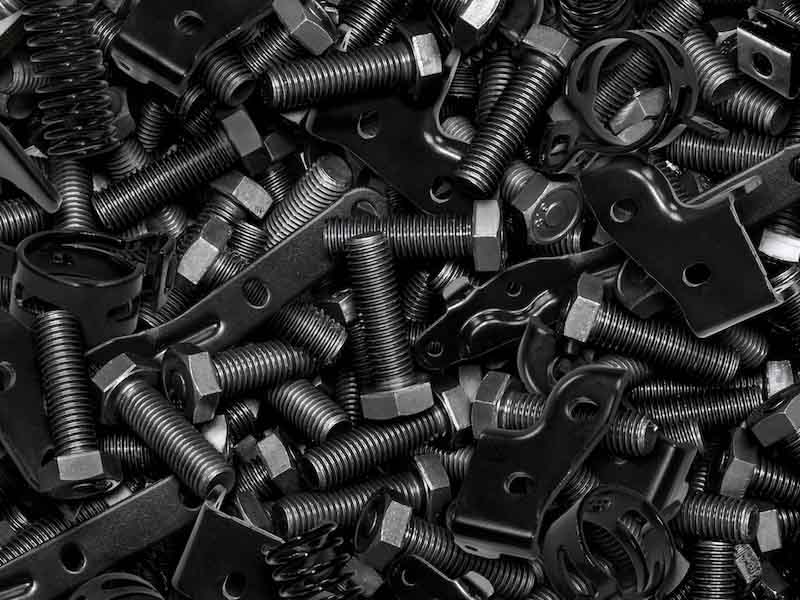From bolts to chassis components and on to engine mounts, automotive vehicles incorporate parts made from a range of different materials which, depending on use, need to satisfy numerous requirements with regard to corrosion protection.
Typically, each individual component requires a special coating precisely tailored to fulfill specification requirements. In order to guarantee long-lasting function and satisfy the strict specifications of the national and international automotive OEMs, different test procedures are applied to evaluate the surface coatings of components used in cars.
Testing the corrosion resistance of components for the automotive market frequently presents problems for developers due to a wide range of stresses, complex requirements, and constantly changing climatic conditions. Outdoor testing usually proves to be difficult as the first signs of corrosion damage typically become evident after a period of many years. In addition, the conditions in outdoor weathering tests vary greatly over time and are seldom constant.
To simulate the various weathering conditions, a distinction is made between different climates – from dry desert to tropical and/or salty conditions by the sea. Once again, the challenge with this approach is the duration of time required for intensive testing is too long. Development findings which confirm if dependable quality has been achieved must be obtained in a more reasonable period of time.
Independent Tests of the Automotive Manufacturers
To assess the quality of components on their vehicles, automotive manufacturers have developed their own procedures to test corrosion resistance. For example, the manufacturer Audi conducts one of the most aggressive tests, the Ingolstädter Korrosions- und Alterungstest (Ingolstadt Corrosion and Ageing Test - INKA). The INKA test involves the simulation of twelve vehicle service years within the period of 19 weeks and consists of five stages. First, the car is sprayed with salt solution in a climate chamber set to 35°C. After this, it is exposed to tropical weathering conditions up to 50°C with a maximum relative humidity of 100%. In the third stage, the vehicle is heated up to 90°C by 80 metal-halide lamps of 1,200 watts each. The colors of the materials in the vehicle interior are not allowed to fade nor become brittle. Simulation of Arctic temperatures as low as minus 35°C occurs in stage four. In this stage, the vehicle is also vibrated with a hydro-pulser. The hydro-pulser shakes the vehicle to recreate the twisting and stress exerted on the body and chassis parts experienced on uneven roads. Finally, the car is driven approximately 7,500 miles on test tracks as well as through gravel roads and muddy trails. Mercedes utilizes a similar test procedure, the MEKO Test, and BMW vehicles are required to prove their corrosion resistance in an extensive Dynamic Corrosion Test (DyCo).
It is clear, however, that these extreme tests can only simulate the actual life of a vehicle and not reflect it completely. Nevertheless, they provide comprehensive findings for the evaluation and optimization of the necessary corrosion protection systems.
Constant Climate Testing in Accordance with ASTM B117
 Test chamber for the salt spray test ASTM B117.In addition to the tests developed by the automotive manufacturers, a less comprehensive procedure for evaluating the corrosion resistance of individual parts and components in vehicle construction is the constant climate, neutral salt spray test performed in accordance to ASTM B117.
Test chamber for the salt spray test ASTM B117.In addition to the tests developed by the automotive manufacturers, a less comprehensive procedure for evaluating the corrosion resistance of individual parts and components in vehicle construction is the constant climate, neutral salt spray test performed in accordance to ASTM B117.
In this test, the coated samples are sprayed continuously with a 5% salt solution at an ambient temperature of 35°C and at 100% relative humidity. To ensure reliable and dependable test results for corrosion resistance are obtained, the temperature conditions and purity of the salt and water quality are precisely specified. In addition, the condensation quantity is collected and maintained within limits according to defined criteria. Corrosive conditions within the constant climate test chamber may be monitored with uncoated test panels. The panels are weighed before and after placement in the test chamber. Upon completion of testing for a defined period of time, the mass loss of the panels is recorded and compared to previous evaluations. The difference in mass loss provides a measure of the corrosivity of the test chamber at each evaluation interval as well as over time.
Given the uniform structure and specified methodology, there are numerous empirical values for a multitude of surface finish systems available for this test procedure in addition to a variety of manufacturers supplying test chambers in the global market.
Climatic Cyclic Tests
Climatic extreme or cyclic tests are also used frequently to evaluate corrosion resistance. These tests typically combine the salt spray test at salt concentrations less than those required per ASTM B117 with defined drying phases and stressing stages which use pure water spray.
 Test chamber for the climatic extremes test (-40/+80°C).Cyclical corrosion tests are characterized by salt spray applications with stages of higher or lower temperatures, stages of higher and lower levels of relative humidity, and alternating drying or rest stages. The variation of salt concentration, humidity, and temperature results in the constant changing of the corrosive environment to provide optimal simulation of realistic environmental conditions. For example, in the GMW14872 cyclical corrosion test components are sprayed with a solution of 0.90% NaCl, 0.1% CaCl2, and 0.075% sodium bicarbonate multiple times in the course of 8 hours. In other stages, the components are exposed to temperatures of 25°C to 60°C and relative humidity of <30% to 100% to complete one daily cycle (duration of test cycle: 24 hours). In the accelerated corrosion tests (ACT) of the Swedish vehicle manufacturer Volvo, components are showered from above in separate stages. During each weekly cycle of the ACT-I test, components are showered with a 1% NaCl solution that has been adjusted to a pH level of 4.2. In addition, the components are exposed to temperatures of 35°C to 50°C and relative humidity of 40% to 95% for defined intervals of time. In the Ford L-467 cyclical corrosion test, components are showered with a 0.5% NaCl solution and exposed to temperatures of 25°C to 50°C and relative humidity of 70% to 95% during the course of each weekly test cycle.
Test chamber for the climatic extremes test (-40/+80°C).Cyclical corrosion tests are characterized by salt spray applications with stages of higher or lower temperatures, stages of higher and lower levels of relative humidity, and alternating drying or rest stages. The variation of salt concentration, humidity, and temperature results in the constant changing of the corrosive environment to provide optimal simulation of realistic environmental conditions. For example, in the GMW14872 cyclical corrosion test components are sprayed with a solution of 0.90% NaCl, 0.1% CaCl2, and 0.075% sodium bicarbonate multiple times in the course of 8 hours. In other stages, the components are exposed to temperatures of 25°C to 60°C and relative humidity of <30% to 100% to complete one daily cycle (duration of test cycle: 24 hours). In the accelerated corrosion tests (ACT) of the Swedish vehicle manufacturer Volvo, components are showered from above in separate stages. During each weekly cycle of the ACT-I test, components are showered with a 1% NaCl solution that has been adjusted to a pH level of 4.2. In addition, the components are exposed to temperatures of 35°C to 50°C and relative humidity of 40% to 95% for defined intervals of time. In the Ford L-467 cyclical corrosion test, components are showered with a 0.5% NaCl solution and exposed to temperatures of 25°C to 50°C and relative humidity of 70% to 95% during the course of each weekly test cycle.
On a range of different test surfaces, the Volvo ACT-II test proves to be a more severe corrosion test. A separate procedure from Japan is the CCT-A (Cyclic Corrosion Test) utilized by Toyota. In the CCT-A test procedure, the parts initially undergo the normal salt spray test before being immersed in a salt solution.
Selecting Corrosion Tests to Suit Individual Requirements
 Test chamber for tests ACT I/ACT II/L467.Corrosion tests permit numerous findings to be obtained for assessing and optimizing the corrosion resistance of steel parts. As these tests can provide an important basis
Test chamber for tests ACT I/ACT II/L467.Corrosion tests permit numerous findings to be obtained for assessing and optimizing the corrosion resistance of steel parts. As these tests can provide an important basis
for the long-term retention of component functionality and service life, it is always important to choose the test that is precisely suited to the specific practical requirements of the respective part. It should be noted, however, that corrosion tests can only simulate the various daily stresses that components are exposed to and can never reflect the full complexity of these real world conditions.
Material furnished by Doerken Coatings North America. For information, contact Albert Gelles at Doerken Coatings North America at www.doerkenusa.com.



































